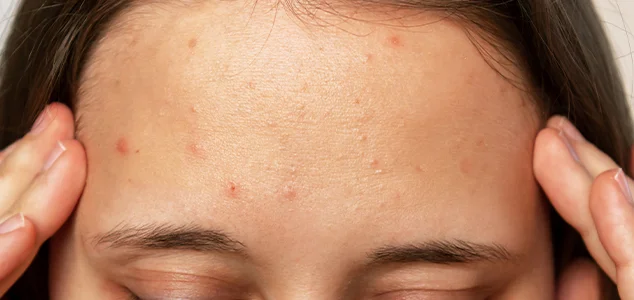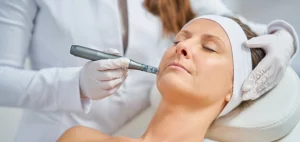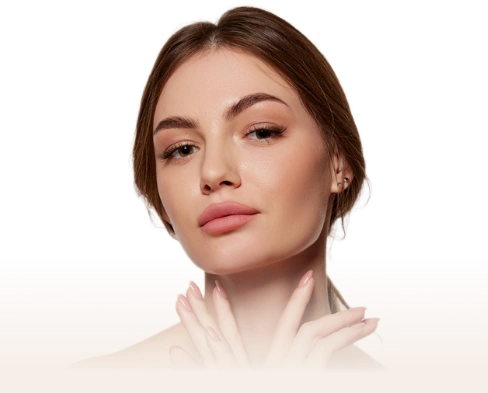Sweat pimples (also called sweat acne or acne mechanica) are small red or white bumps that appear when sweat mixes with oil, bacteria, and dead skin, clogging pores. They’re most common in hot, humid weather or after workouts, especially if sweat isn’t washed away promptly.
- Looks Like: Small red or pink bumps; some may have a white tip; can feel itchy, warm, or tender to touch.
- Main Triggers: Heat, high humidity, tight or non-breathable clothing, unwashed sweat after exercise, and friction from gear or straps.
- Quick Relief: Shower or cleanse the skin as soon as possible after sweating, wear loose cotton or moisture-wicking fabrics, and use a gentle salicylic acid or benzoyl peroxide cleanser to clear pores and reduce bacteria.
If bumps are itchy, appear in clusters, or don’t respond to standard acne treatments, you may be dealing with fungal folliculitis — in which case an antifungal cleanser (like ketoconazole) can help.
What Are Sweat Pimples & Sweat Acne?
Sweat pimples and sweat acne are skin conditions triggered by a combination of heat, sweat, oil, bacteria, and friction.
They often appear in hot, humid environments or after physical activity, especially when sweat isn’t washed off promptly.
- Sweat Pimples – General term for small, red or white bumps caused by sweat clogging pores or irritating hair follicles. May also include heat rash (miliaria) or folliculitis.
- Sweat Acne – A form of acne breakouts specifically aggravated by sweat and friction, often overlapping with acne mechanica. Involves typical acne lesions like whiteheads, blackheads, papules, and pustules.
How Are Sweat Pimples Different From Regular Acne?
| Aspect | Sweat Acne | Sweat Pimples |
| Primary Trigger | Clogged pores from sweat + oil + bacteria. | Sweat irritation or trapped moisture in follicles. |
| Common Cause #1 | Overproduction of sebum combined with sweat and dead skin cells. | Blocked sweat glands (miliaria) or surface irritation. |
| Common Cause #2 | Growth of Cutibacterium acnes in sweaty conditions. | Overgrowth of yeast/bacteria, especially with tight clothing. |
| Common Cause #3 | Friction from gear/clothing (acne mechanica). | Trapped sweat from occlusive fabrics or poor ventilation. |
| Sweat’s Role | Increases oiliness, opens pores, then traps debris inside. | Creates a moist, warm setting for irritation or blockage. |
| Appearance | Whiteheads, blackheads, pustules, papules. | Small red or white bumps, sometimes itchy or tender. |
| Related Conditions | Body acne, hormonal acne. | Heat rash, folliculitis. |
| Aggravating Factors | Not washing post-workout, oily skin, makeup during exercise. | Tight fabrics, poor airflow, synthetic clothing. |
| Common Locations | Forehead, back, chest, jawline. | Chest, back, under breasts, inner thighs, buttocks. |
What Does Sweat Acne Look Like?
Sweat pimples, appearing as red or pink bumps from accumulated sweat, differ from the traditional acne’s blackheads. Acne mechanica, caused by friction from athletic gear, results in papules, pustules, or nodules. Papules and pustules, forms of inflammatory acne, are red bumps with pustules having a pus-filled white top. Nodules, indicating more severe infection, are painful and deeper under the skin.

Sweat acne on back

What Does Sweat Pimple Look Like?

Sweat bumps on the face
Sweat bumps on the face are small, raised spots that often develop after sweating, especially in hot or humid environments. They can be caused by blocked sweat ducts (miliaria), where sweat becomes trapped beneath the skin, friction and heat from items like hats, headbands, or masks, bacterial or fungal folliculitis from sweat mixing with microorganisms in the hair follicles, or product buildup from makeup, sunscreen, or heavy skincare that clogs pores.
Treating sweat bumps involves cleansing the face gently after sweating with a mild, fragrance-free cleanser or micellar water, using breathable and non-comedogenic products, and cooling the skin with a cold compress or aloe vera gel to reduce inflammation. If the bumps are itchy or appear in clusters, an antifungal cleanser like ketoconazole (Nizoral) or an antibacterial wash with benzoyl peroxide may help.
Light exfoliation with salicylic acid two to three times a week can also prevent pore blockages, though harsh scrubbing should be avoided. Wearing loose, breathable headgear can further reduce friction and allow sweat to evaporate. If sweat bumps persist for more than a week, worsen, or spread, consulting a dermatologist is recommended to rule out conditions like fungal folliculitis.
Causes of Sweat Pimples & Sweat Acne
Sweat itself isn’t harmful, but when mixed with oils, dirt, and bacteria, it can clog pores and lead to acne. This is worsened by high humidity, pollution, and tight, non-breathable clothing, which trap sweat and irritate the skin. Intense exercise can also increase acne risk if sweat isn’t washed off promptly.
Additionally, fungal acne, caused by an overgrowth of yeast (Malassezia), can be exacerbated by sweat, leading to persistent, itchy bumps. Managing these factors can help reduce sweat-induced acne and improve skin health.
Sweat pimples and sweat acne share similar root causes both are triggered by a mix of excess heat, trapped moisture, and pore blockage. The main difference is whether the bumps are true acne lesions or irritation-related folliculitis.
1. Heat & Humidity
- Warm, moist conditions open pores and increase sweating.
- Sweat left on the skin creates a breeding ground for bacteria and yeast.
- Common in tropical climates, summer months, and poorly ventilated environments.
2. Sweat + Oil + Bacteria Build-Up
- Sweat mixes with sebum (skin oil), dead skin cells, and environmental dirt.
- This combination clogs pores, trapping bacteria like Cuti Bacterium acnes or yeast (Malassezia).
- Leads to inflammation, whiteheads, blackheads, and pustules.
3. Friction & Pressure (Acne Mechanica)
- Tight clothing, sports gear, straps, and helmets create repetitive rubbing on sweaty skin.
- Friction weakens the skin barrier, pushing debris into pores.
- Often seen in athletes, gym-goers, and workers wearing heavy gear.
4. Occlusive Clothing & Fabrics
- Synthetic, non-breathable fabrics trap sweat against the skin.
- Poor airflow prevents sweat from evaporating, worsening blockage.
- Leggings, compression gear, and certain uniforms are common culprits.
5. Poor Sweat Management
- Delayed showering after workouts allows sweat to sit on the skin for hours.
- Reusing unwashed workout clothes introduces additional bacteria.
- Heavy makeup or skincare during sweating further traps debris.
6. Environmental & Lifestyle Factors
- Pollution: Dust and particulate matter combine with sweat to block pores.
- Stress: Increases oil production and sweat output.
- Hormonal changes: Puberty, menstrual cycles, or high-androgen states increase sebum production.
7. Fungal Overgrowth (Fungal Folliculitis)
- Sweat and heat encourage yeast (Malassezia) growth.
- Bumps appear in clusters, are often itchy, and don’t respond to standard acne treatments.
How to Get Rid of Sweat Pimples & Sweat Acne (Dermatologist-Approved)?
Several treatments can effectively address sweat-induced acne by targeting inflammation, bacteria, and clogged pores. Options include advanced therapies like laser treatments, chemical peels, and facials, as well as daily skincare products and lifestyle adjustments.
Laser Therapy
Laser therapy uses focused light to target and reduce acne-causing bacteria and inflammation, helping to clear sweat-induced breakouts. Per session of laser therapy cost around $200 – $500. The treatment duration of laser therapy is 30 minutes per session.
Chemical Peel
Chemical peels involve applying a chemical solution to exfoliate the skin, removing dead skin cells, and unclogging pores to reduce acne. The cost of chemical peel is $100 – $300 per session. It usually takes around 30-60 minutes.
Facials
Facials include deep cleansing, exfoliation, and extractions to help manage sweat acne and improve overall skin clarity. It costs around $80 – $150 per session. The treatment duration of facials is 60 minutes.
Anti-Acne Soaps and Cleansers
Use specialized soaps and cleansers to remove excess oil and bacteria from the skin, which can help prevent and treat acne.
Acne Creams and Gels
Topical treatments containing ingredients like salicylic acid or benzoyl peroxide can target acne and reduce breakouts.
Opt for Breathable Fabrics
Choose natural, moisture-wicking materials like cotton to help sweat evaporate and reduce skin irritation.
Wear Loose-Fitting Clothes
Avoid tight or restrictive clothing that can trap sweat against the skin and cause additional irritation.
Effective and Safe Home Remedies for Acne
While medical treatments and OTC products are often most effective, some gentle home remedies can complement your routine:
- Aloe Vera Gel – Apply a thin layer of fresh aloe vera gel to the affected area, leave for 10–15 minutes, then rinse. Soothes inflammation, cools the skin, and has mild antibacterial benefits.
- Diluted Tea Tree Oil – Mix a few drops of tea tree oil with a carrier oil (like jojoba or coconut oil) before applying with a cotton swab. Known for its antimicrobial and anti-inflammatory properties.
- Green Tea Compress – Brew and cool green tea, apply to the skin with a cotton ball or clean cloth for 10–15 minutes. Helps calm redness and reduce inflammation due to its antioxidants.
- Oatmeal Paste or Bath – Blend plain oats into a fine powder, mix with water into a paste, and apply for 15–20 minutes, or add to a lukewarm bath. Soothes irritation and absorbs excess oil.
How to Get Rid of Sweat Acne & Sweat Pimples (Location-Specific Tips)
| Area | Sweat Acne – Targeted Tips | Sweat Pimples – Targeted Tips |
| Forehead | Avoid greasy hair products; keep headbands clean; choose moisture-wicking headgear. | Use a cool compress if bumps are irritated; ensure hats/helmets are washed regularly. |
| Hairline | Use acne-safe shampoo (no sulfates/oils); rinse sweat from hairline after workouts. | Dab with a clean towel during activity; avoid tight headbands. |
| Face (Cheeks, Jawline) | Use benzoyl peroxide spot treatment for inflamed spots; avoid heavy makeup during workouts. | Apply soothing aloe vera gel for red bumps; use micellar water wipes after sweating. |
| Neck | Use gentle exfoliation 2–3× per week to prevent buildup in folds. | Pat dry and avoid friction from collars or scarves. |
| Chest | Rotate sports bras/tops to prevent bacterial buildup; consider antifungal wash if itching. | Apply anti-chafing powder in humid weather. |
| Back (Bacne) | Avoid heavy backpacks post-sweat; use diluted tea tree oil on stubborn areas. | Light oatmeal paste applications for itch relief. |
| Shoulders | Skip shoulder bags that rub when sweating. | Apply a calming lotion after workouts. |
| Armpits | Switch to non-comedogenic deodorants if irritation occurs. | Try antibacterial cleansers if prone to folliculitis. |
| Buttocks | Wear cotton underwear; consider antifungal wash for persistent bumps. | Use zinc oxide cream for friction-prone spots. |
| Thighs (Inner) | Apply anti-chafing balm before workouts. | Use cool, soothing creams after friction. |
| Groin | See a dermatologist for persistent lesions (often folliculitis, not acne). | Use breathable fabrics and cool showers. |
| Scalp | Use a clarifying shampoo weekly to remove sweat/product buildup. | Rinse scalp thoroughly after sweating; avoid heavy styling creams. |
How To Prevent Acne From Sweating?
To prevent sweat pimples, consider the following tips:
- Shower Regularly: Wash your skin with a gentle, anti-acne cleanser as soon as possible after sweating to remove sweat, oils, and bacteria.
- Use Exfoliating Products: Incorporate exfoliating scrubs or products with salicylic acid into your routine to help unclog pores and prevent acne.
- Avoid Touching Your Face: Keep your hands away from your face to prevent transferring oils and bacteria from your hands to your skin.
- Choose Breathable Fabrics: Opt for loose, moisture-wicking clothing made of natural materials like cotton to allow sweat to evaporate and reduce skin irritation.
- Maintain a Consistent Skincare Routine: Use non-comedogenic (non-pore-clogging) skincare products to keep your skin clean and balanced.
- Stay Hydrated: Drink plenty of water to help regulate your body’s temperature and reduce excessive sweating.
- Manage Stress: High-stress levels can increase sweat production, so practice stress-relief techniques such as exercise, meditation, or deep breathing exercises.
- Avoid Heavy Makeup: If you wear makeup, choose non-comedogenic products and ensure you remove it thoroughly after sweating.
Implementing these tips can help prevent sweat-induced acne and maintain clearer, healthier skin.
Sweat Pimples vs Heat Rash
While both can appear during hot, humid weather, they have different causes:
Sweat Pimples (Sweat Acne) – Caused when sweat mixes with oil, dead skin, and bacteria, clogging pores. May present as whiteheads, blackheads, or inflamed bumps.
Heat Rash (Miliaria) – Caused by blocked sweat ducts, trapping sweat under the skin. Appears as tiny, red, itchy bumps or clear blisters, often with a prickly sensation.
Sweat pimples involve pore blockage and often bacteria or yeast, while heat rash is a sweat duct blockage. Treatment for sweat pimples focuses on unclogging pores and reducing bacteria; heat rash treatment focuses on cooling the skin and allowing sweat to escape.
Does Sweating Cause Acne?
No, sweating itself does not directly cause acne, but it can contribute to breakouts if certain conditions are present, particularly if sweat is not managed properly. Here’s how it can affect different areas of the body:
- Forehead and Face: Sweat can mix with oils and bacteria on the skin, leading to clogged pores and potential breakouts. This is especially true for individuals who sweat heavily or do not wash their face after sweating.
- Back and Chest: These areas, often called “bacne” and “chest acne,” are prone to sweat-related acne because sweat can easily become trapped in pores on these parts of the body, leading to inflammation and pimples.
- Arms: While less common, sweat can also contribute to acne on the arms, particularly if sweat is trapped by tight or non-breathable clothing.
- Blackheads: Sweat itself does not cause blackheads, but the buildup of sweat, oils, and dead skin cells can clog pores and lead to the formation of blackheads.
Sweating has mixed effects on acne. On the positive side, sweating can help clear out pores and improve circulation, which may benefit overall skin health. However, if sweat is not washed away promptly, it can mix with oils and bacteria, potentially leading to clogged pores and acne.
Does Sweating Help or Hurt Acne?
Sweating can have both good and bad effects. It helps flush out pores and improve circulation, but if sweat isn’t removed quickly, it creates a warm, moist environment for bacteria and yeast to thrive, potentially worsening acne. The key is to rinse off as soon as possible after sweating.
Why Do I Keep Breaking Out In Sweats?
Frequent breakouts in sweat can be attributed to several factors:
- Excessive Sweating: High levels of perspiration can mix with oils and bacteria on the skin, leading to clogged pores and sweat pimples. This is especially common in areas where sweat accumulates, such as the back, chest, and forehead.
- Poor Hygiene: Not washing sweat off promptly can allow sweat to linger on the skin, increasing the risk of clogged pores and sweat pimples.
- Environmental Factors: High humidity and heat can exacerbate sweating and contribute to acne. In such conditions, sweat combines with other irritants, aggravating skin issues.
- Clothing Choices: Wearing tight or non-breathable fabrics can trap sweat and bacteria against the skin, leading to irritation and acne.
- Hormonal Fluctuations: Changes in hormone levels, such as during puberty, menstruation, or stress, can increase oil production and exacerbate acne breakouts, making sweat pimples more likely.
- Underlying Skin Conditions: Conditions like fungal acne can be aggravated by sweat. Fungal acne, caused by an overgrowth of yeast, can appear as small, uniform bumps and is often itchy.
Sweat Acne Treatment in Manhattan, NYC
In Manhattan, the combination of high humidity and pollution can aggravate sweat acne, making timely treatment essential. Dr. Syra Aesthetics is a leading clinic specializing in advanced facials, chemical peels, and laser therapies tailored to address sweat acne. Begin by scheduling a consultation with Dr. Syra Hanif, an expert, board-certified dermatologist, to assess your skin condition and discuss personalized treatment options. Based on your needs, you can choose from their recommended in-clinic treatments and follow a customized skincare routine designed to manage sweat pimples effectively.
By addressing local environmental factors and seeking professional care, you can treat sweat acne more efficiently and maintain healthier skin. For more information or to book an appointment, contact Dr. Syra Aesthetics online or call +1-646-912-8020 to learn more about the most effective sweat acne treatments tailored for you.
Frequently Asked Questions
What skincare is good for sweat pimples?
Use a gentle cleanser to remove sweat, exfoliate regularly to prevent clogged pores, and apply a non-comedogenic moisturizer to keep skin balanced.
Does diet play a role in hormonal acne?
Yes, diet can impact hormonal acne by affecting hormone levels and inflammation. Foods high in sugar and dairy may exacerbate acne.
How should I treat my acne-prone skin?
Treat acne-prone skin by using gentle cleansers, applying products with salicylic acid or benzoyl peroxide, avoiding heavy or oily cosmetics, and moisturizing with non-comedogenic lotions.
What kills acne-causing bacteria?
Acne-causing bacteria are killed by benzoyl peroxide, salicylic acid, and topical antibiotics like clindamycin or erythromycin. Proper hygiene and antibacterial cleansers also help.
Can the Right Diet Get Rid of Acne?
A balanced diet can help manage acne but may not be a complete solution. Reducing high glycemic index foods, like sugary snacks and white bread, can prevent blood sugar spikes that worsen acne. Omega-3 fatty acids from fatty fish and flaxseeds can reduce inflammation, while antioxidant-rich foods like berries and leafy greens combat oxidative stress. Limiting dairy may also be beneficial, as some studies link dairy with acne. Staying hydrated supports skin health and helps flush out toxins. The impact of diet on acne varies, so combining dietary changes with a good skincare routine and acne treatments is usually the best approach.
How long do sweat pimples last?
Sweat pimples typically last 3 to 7 days if properly cleaned and left undisturbed. Persistent or worsening bumps may indicate folliculitis or fungal acne.
Are sweat pimples the same as heat rash?
No — sweat pimples are often clogged pores or folliculitis caused by trapped sweat, while heat rash (miliaria) is due to blocked sweat ducts, resulting in tiny, itchy red bumps.
Best cleanser for sweat pimples?
Use a gentle salicylic acid cleanser (e.g., CeraVe SA Cleanser or Neutrogena Oil-Free Acne Wash) to unclog pores and reduce inflammation. For possible fungal causes, try Nizoral (ketoconazole) shampoo as a face wash 2–3 times a week.
Do I have fungal acne from sweat?
You might if the bumps are:
- Itchy
- In clusters
- Don’t respond to acne treatments
- Located on the forehead, chest, back, or shoulders
Fungal acne = Malassezia folliculitis, often triggered by sweat + humidity. Try an antifungal cleanser (e.g., Nizoral), and wear breathable fabrics.

About The Author
Dr. Syra Hanif M.D.
Board Certified Primary Care Physician
Dr. Hanif is the Director of Aesthetic Medicine. She is a board-certified physician in Aesthetic Medicine who specializes in using non-surgical alternatives in order to enhance one's appearance through Botox and fillers.
Read More










